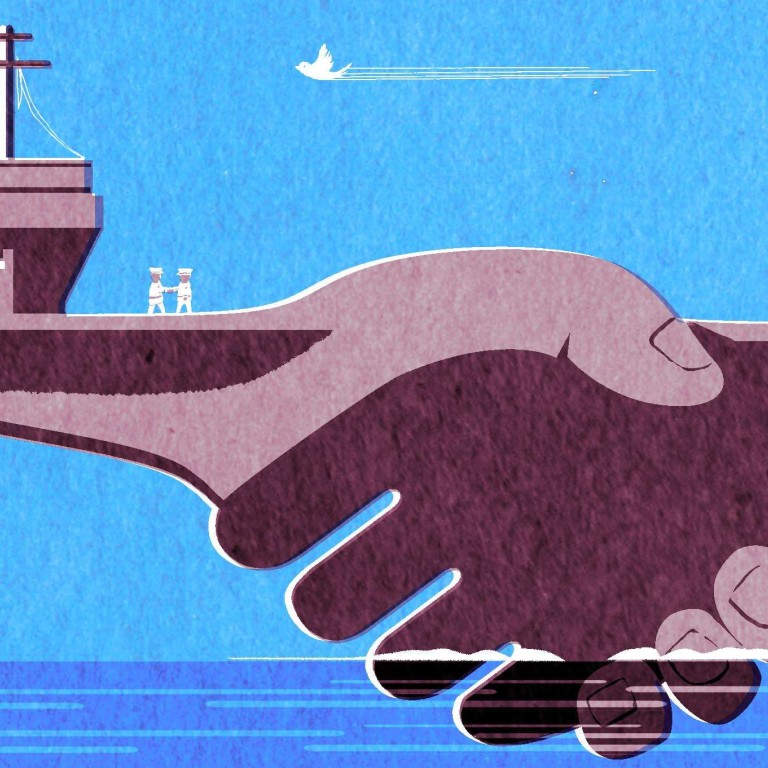
US and China need more soft power, not military hardware, to resolve their differences
Tom Plate says history is moving in the direction of China and Asia, and America would do well to favour understanding over grandstanding

In writing for newspapers about Asia and China since 1996, informative exchanges would routinely arise with members of the US military, especially the razor-sharp heads of the Pacific Command at Pearl Harbour. Standouts in my mind included admirals Joseph Prueher, who was later to become ambassador to China (and help defuse the nasty 2001 Hainan Island incident); Dennis Blair, later President Barack Obama’s first director of National Intelligence (and famous as the first skipper of a destroyer to water ski in his ship’s wake); and Thomas Fargo, a charismatic submarine commander behind the character “Commander Bart Mancuso” (Scott Glenn) in the action film The Hunt for Red October.

US warships to visit Spratlys ‘twice a quarter’ in South China Sea but ‘pose no threat’
The current Pacific Command head is Harry Harris – the first Asian American to make admiral (this has got to be generally good for Asia). Born in Yokosuka (and raised in the US South), Harris is the navy’s highest-ranking Japanese American (this perhaps being less good for China). His fabulous education: the Naval Academy (of course), Harvard’s Kennedy School of Government, Georgetown’s School of Foreign Service, Oxford University and even MIT.
[Harris’] talk did plainly pivot on the assumption that the best response to China’s push in its own neighbourhood was to push China back
This articulate and personable navy aviator not only saw his career zoom, but touched down in Washington at one point as a joint chiefs of staff speech writer. And it was his verbal dexterity that shone during a recent speech at a hotel in Los Angeles, courtesy of the Asia-alert LA World Affairs Council. The navy fly boy had previously caused a buzz (famous in Washington, infamous in Beijing) for this wise crack about the South China Sea: “[China is] creating a great wall of sand.”
In LA, though the admiral did not throw any sand in China’s face, his talk did plainly pivot on the assumption that the best response to China’s push in its own neighbourhood was to push China back, even though it’s China’s own neighbourhood. Noting China’s rejection of an arbitral tribunal’s South China Sea ruling, and – as a key factor in North Korea’s nuclear buildup – fingering Beijing’s tepidity in failing to stare Pyongyang down, Harris’ pitch was rather brutally binary “good guy, bad guy”. He was pushy on the need for more military hardware, sparing on the need for deft and aggressive diplomacy.

Why the US policy on South China Sea only helps China
Washington has been posting more and more ships to the Asia-Pacific but Harris cannot hide his glee at the new ones coming his way: “The lead ship, USS Zumwalt, is scheduled to be commissioned next month ... This region is getting a ship even the Klingons would fear. And the destroyer skipper’s name is Captain James Kirk. You just can’t make this stuff up. Jokes aside, this is serious business. If we have to fight tonight, I don’t want it to be a fair fight. If it’s a knife fight, I want to bring a gun. If it’s a gunfight, I want to bring in the artillery...”
America’s quarrel is thus not only with China but with history – and with many parts of Asia
The few Chinese diplomats from the local consulate in the ballroom audience sat admirably quiet. They did not jump up to ask whether the prime cause of North Korea’s buildup was Beijing’s timidity – or, rather, Washington’s diplomatic frigidity. And the admiral was little short of a travelling salesman for THAAD, the brutally expensive missile defence gadget proclaimed by Washington not to be offensive to Beijing but defensive only as regards North Korea.

From an Asian perspective, the great wall of the cold war fell more than a quarter of a century ago. So history moves on, but this time in the direction of China and Asia.

My last quote from Admiral Harris: “Everything that’s ‘new in cool’ in the US military arsenal is coming first to the Pacific.” Oh my. Even America’s best-educated military leaders need to keep steeping.
Loyola Marymount University professor Tom Plate is vice-president of the Los-Angeles based Pacific Century Institute

